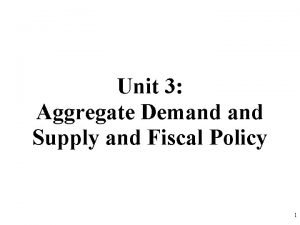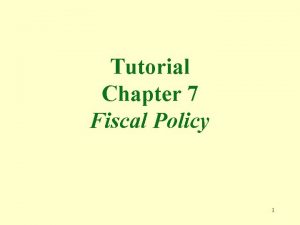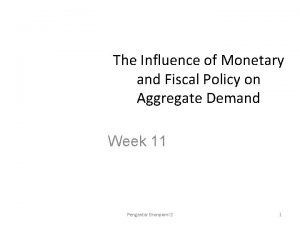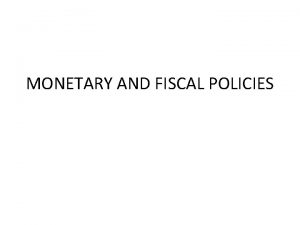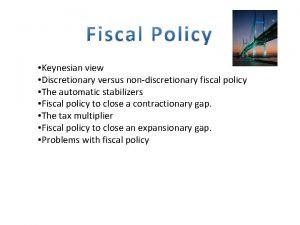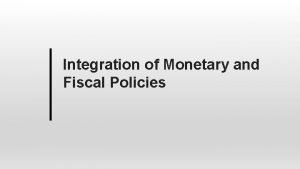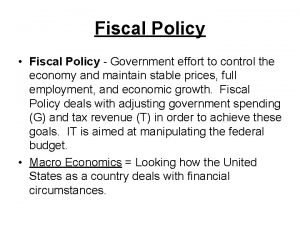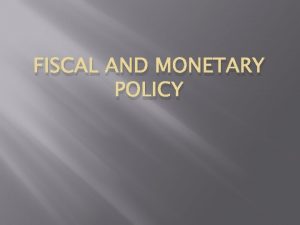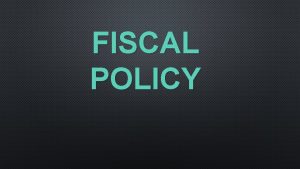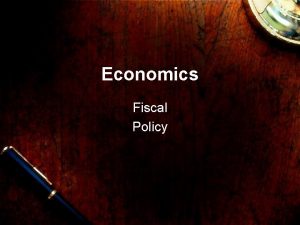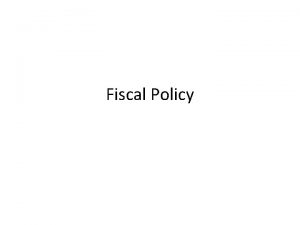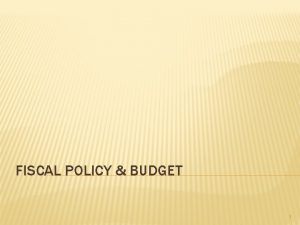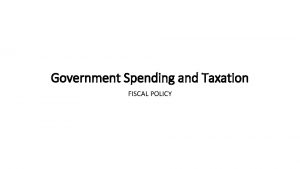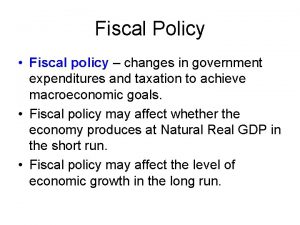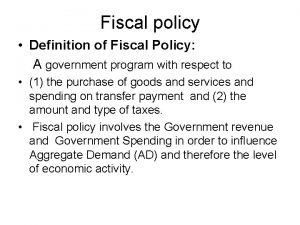Chapter Ten Fiscal Policy The Role of Government














- Slides: 14

Chapter Ten: Fiscal Policy

The Role of Government Spending and Taxes

Table 10. 1: An Increase in Government Spending

Figure 10. 1: Increased Government Spending Aggregate Demand Output Full Employment E 1 800 AD 1 (G = 80) AD 0 (G = 0) Full Employment Equilibrium 400 E 0 (Unemployment Equilibrium) 160 80 45° 400 800 Y* Income (Y)

Figure 10. 2: A Macroeconomic Model with Government Spending and Taxes Output (Y) Production generates income to households Income (Y) Sav ings consumption (C) Spending (AD) G ov es t. T ax Ne er n m en t. S pe n di ng Intende d Investm ent Government Banks and Financial System

The Federal Budget

Figure 10. 3 a: United States Government Source of Funds and Outlays, Fiscal 2011 Borrowing to cover deficit (36%) Personal income taxes (30%) Social insurance and retirement taxes (23%) Excise, estate, and other taxes (6%) Corporate taxes (5%)

Figure 10. 3 b Justice, government administration (2%) Interest on debt (6%) Science, natural resources, transportation (5%) Social security, Medicare (33%) Health (10%) Income security, education, social services (20%) National defense, veterans, foreign affairs (24%)

Figure 10. 4: Federal Surplus of Deficit as a Percent of GDP 10. 0 Percentage of GDP 5. 0 0. 0 1940 -5. 0 -10. 0 -15. 0 -20. 0 -25. 0 -30. 0 -35. 0 1950 1960 1970 1980 1990 2000 2010

Figure 10. 5: Federal Outlays, Receipts, and Surplus/Deficit, as a Percent of GDP, 1980 -2011 Percent of GDP Outlays Source: Economic Report of the President 2012, Table b-79. Receipts Surplus or Deficit

Policy Issues

Figure 10. 6: Crowding Out in the Loanable Funds Market Crowding out

Aggregate demand output Figure 10. 7: A Reduction in the Proportional Tax Rate AD 1 (decrease in t) AD 0 (original t) E 1 Slope = mpc(1 t) E 0 45° Y 0 Y 1 Income (Y)

Table 10. 2: Different Multiplier Effects Tax Cuts Nonrefundable Lump-Sum Tax Rebate Refundable Lump-Sum Tax Rebate Temporary Tax Cuts Payroll Tax Holiday Across the Board Tax Cut Accelerated Depreciation Permanent Tax Cuts Extend Alternative Minimum Tax Patch Make Bush Income Tax Cuts Permanent Make Dividend and Capital Gains Tax Cuts Permanent Cut Corporate Tax Rate Spending Increases Extend Unemployment Insurance Benefits Temporarily Increase Food Stamps Issue General Aid to State Governments Increase Infrastructure Spending Multiplier 1. 02 1. 26 1. 29 1. 03 0. 27 0. 48 0. 29 0. 37 0. 30 1. 64 1. 73 1. 36 1. 59 Source: M. Zandi, “The Economic Impact of the American Recovery and Reinvestment Act, ” Moody’s Economy. com, 2009.
 Ví dụ về giọng cùng tên
Ví dụ về giọng cùng tên Môn thể thao bắt đầu bằng từ chạy
Môn thể thao bắt đầu bằng từ chạy Conclusion of monetary policy
Conclusion of monetary policy Example fiscal policy
Example fiscal policy Government expenditure multiplier formula
Government expenditure multiplier formula Components of fiscal policy
Components of fiscal policy Crowding out effect of fiscal policy
Crowding out effect of fiscal policy Contractionary monetary policies
Contractionary monetary policies What is liquidity ratio in banking
What is liquidity ratio in banking Non-discretionary fiscal policy
Non-discretionary fiscal policy Tools of fiscal policy
Tools of fiscal policy Fiscal policy ib
Fiscal policy ib Fiscal demand side policy
Fiscal demand side policy Fiscal policy definition
Fiscal policy definition Types of fiscal policy
Types of fiscal policy



